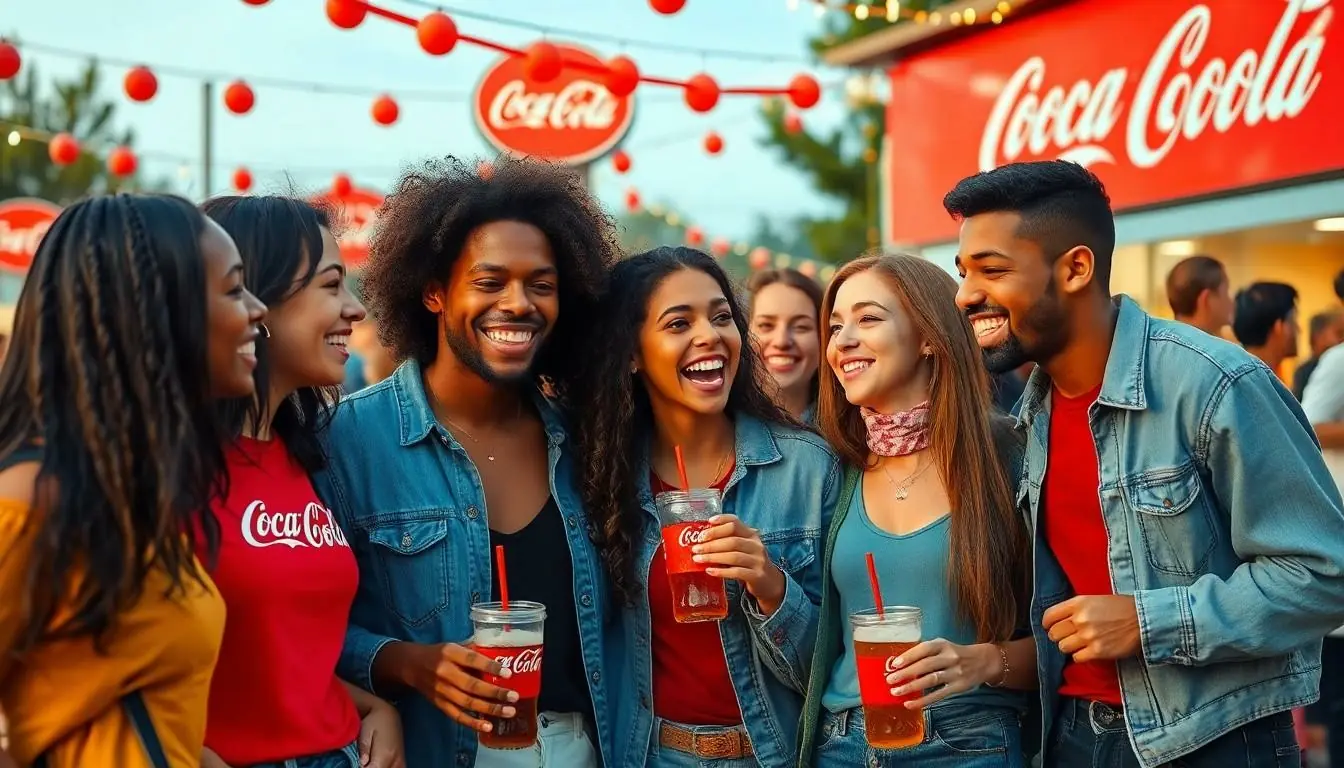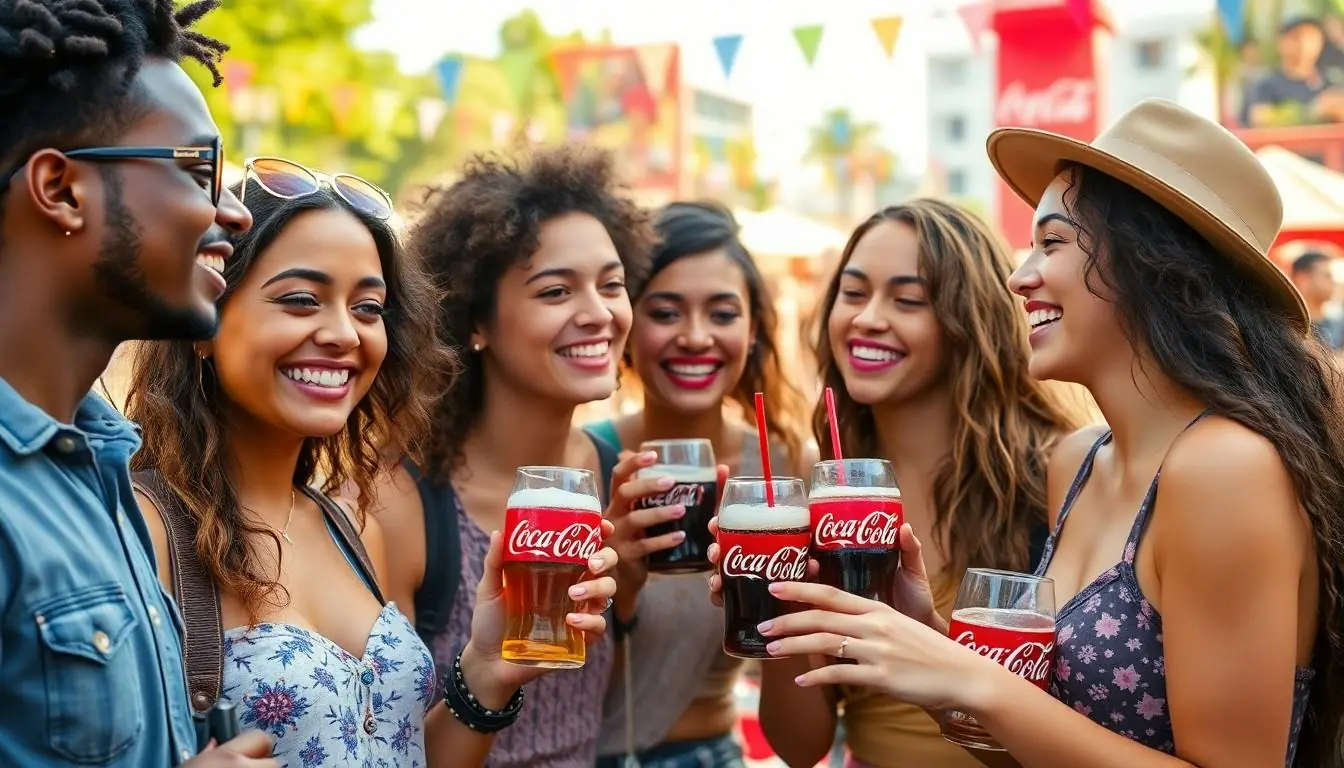Coca-Cola isn’t just a drink; it’s a cultural phenomenon that’s been refreshing people for over a century. With a marketing strategy as fizzy as its signature beverage, Coca-Cola knows how to pop off the shelves and into hearts. From memorable jingles to iconic ad campaigns, they’ve mastered the art of making consumers feel like they’re part of something bigger—like a global family that just happens to love bubbles.
But what’s the secret sauce behind their success? It’s not just the sugar rush; it’s a blend of creativity, nostalgia, and a sprinkle of humor. Whether it’s sharing a Coke with friends or cozying up with a movie, Coca-Cola’s marketing hits all the right notes. Dive into the bubbly world of Coca-Cola’s marketing strategy and discover how they keep their brand as refreshing as the drink itself.
Table of Contents
ToggleOverview of Coca Cola Marketing Strategy
Coca-Cola’s marketing strategy emphasizes emotional connection and brand identity. The brand leverages nostalgia through campaigns featuring classic songs and visuals. Creative advertisements often showcase shared moments, emphasizing the beverage’s role in gatherings and celebrations. Coca-Cola fosters community engagement with initiatives like the Share a Coke campaign, inviting consumers to personalize their drinks.
Moreover, the brand consistently utilizes social media to engage younger audiences. Strategies integrate user-generated content and hashtag campaigns to enhance interaction. Events and sponsorships, such as the FIFA World Cup and Olympic Games, elevate global visibility and reinforce brand association with joy and togetherness.
Coca-Cola also employs targeted segmentation for markets worldwide. Each campaign adapts messaging and imagery to resonate with local cultures and traditions. Research highlights how regional campaigns, like those focusing on popular sports or local customs, effectively increase consumer interest and drive sales.
Data supports the effectiveness of Coca-Cola’s marketing techniques. Surveys indicate that over 80% of consumers feel a sense of loyalty to the brand, influenced by its continuous outreach and emotional storytelling. Fostering this loyalty involves consistent branding across various platforms while maintaining a fresh approach in advertising campaigns.
The brand’s commitment to sustainability and social responsibility resonates with modern consumers. Initiatives like World Without Waste reflect a dedication to environmental impact while reinforcing positive brand perception. Aligning with consumer values enhances trust and loyalty toward Coca-Cola’s products.
Target Audience Analysis
Coca-Cola’s marketing strategy effectively targets diverse consumer segments, ensuring strong brand loyalty and engagement. By understanding their audience, the brand creates compelling campaigns that resonate deeply.
Demographic Factors
Coca-Cola focuses on specific demographic factors, including age, income, and location. The brand appeals to all age groups, especially younger consumers aged 18 to 34. Gender balance remains crucial, as both men and women enjoy Coca-Cola products. Regional marketing strategies address local preferences, adapting flavors and promotions to suit tastes in different countries. For instance, middle-income consumers often connect with value-driven campaigns, while premium offerings attract higher-income shoppers.
Psychographic Factors
Psychographic factors play a vital role in shaping Coca-Cola’s marketing initiatives. The brand emphasizes lifestyle choices, associating its products with happiness and togetherness. Advertisements reflect themes of friendship, nostalgia, and celebration, fostering emotional connections. Consumers who prioritize sustainability and social responsibility resonate with Coca-Cola’s initiatives, such as World Without Waste. Insights show that community engagement enhances brand loyalty, with many individuals identifying with the values Coca-Cola promotes. By tapping into these psychographics, Coca-Cola cultivates a loyal customer base that feels a part of the brand’s story.
Key Marketing Tactics
Coca-Cola employs various marketing tactics that establish strong connections with consumers and enhance brand loyalty.
Advertising Campaigns
Coca-Cola’s advertising campaigns stand out for their creativity and emotional resonance. Iconic jingles, memorable visuals, and nostalgia-driven themes engage audiences effectively. Campaigns like “Share a Coke” invite personalization, making consumers feel valued. Each advertisement reinforces the brand’s connection to happiness, unity, and celebration. The company’s ability to adapt its messaging during holiday seasons amplifies its presence in everyday life. Notably, Coca-Cola’s campaigns have reached billions globally, reinforcing its cultural significance.
Social Media Engagement
Engagement on social media platforms plays a crucial role in Coca-Cola’s marketing strategy. Innovative user-generated content encourages consumers to share their Coke moments, strengthening community ties. Campaigns utilizing hashtags like #ShareaCoke promote interaction and amplify brand visibility. Interactive content, contests, and influencer collaborations capture the attention of younger audiences effectively. This approach builds a sense of belonging while fostering brand loyalty among followers. Regular updates across platforms maintain relevance, ensuring the brand stays top-of-mind.
Sponsorships and Partnerships
Strategic sponsorships and partnerships enhance Coca-Cola’s marketing reach and position. Major events like the FIFA World Cup and Olympic Games showcase the brand to millions, aligning it with celebration and joy. Partnerships with popular music festivals engage audiences through unique experiences. Collaborative promotions with diverse brands expand Coca-Cola’s market presence and attract new consumers. Each sponsorship reinforces the brand’s ethos, promoting connection and shared moments. Success in these arenas demonstrates Coca-Cola’s effective marketing strategy in cultivating a loyal consumer base.
Product Positioning
Coca-Cola’s product positioning centers on emotional connections and a strong brand identity. The brand consistently evokes feelings of happiness, nostalgia, and togetherness, resonating with consumers worldwide.
Brand Image and Identity
Coca-Cola cultivates a vibrant brand image that symbolizes joy and shared experiences. It’s known for memorable ads that showcase moments of celebration, reinforcing its place in consumers’ lives. People associate the brand with enjoyment and community, aided by iconic visuals and jingles. Nostalgia plays a crucial role, as many consumers recall past experiences tied to the beverage. The brand maintains a consistent tone across various platforms, which helps solidify its identity. Data confirms that over 80% of consumers express loyalty to Coca-Cola, largely due to its relatable messaging and emotional storytelling.
Innovation and Product Diversification
Coca-Cola embraces innovation and product diversification as essential components of its marketing strategy. The brand introduces new flavors and variations to cater to evolving consumer preferences. Seasonal drinks and limited-edition flavors generate excitement and tap into current trends. Additionally, Coca-Cola continuously explores healthier options, responding to the growing demand for low-sugar beverages. Sustainability initiatives, such as using recyclable packaging, reflect the brand’s commitment to environmental responsibilities. By aligning its products with consumer values, Coca-Cola strengthens brand loyalty and maintains relevance in a competitive market.
Challenges and Areas for Improvement
Despite Coca-Cola’s strong marketing strategy, several challenges impact its effectiveness. Competition in the beverage industry intensifies, with new brands emerging frequently. These new entrants often target health-conscious consumers, making it crucial for Coca-Cola to innovate beyond its traditional offerings.
Sustainability issues also present a challenge. While Coca-Cola emphasizes recyclable packaging, public scrutiny around plastic waste rises. Addressing this concern requires transparency in sustainability initiatives to maintain consumer trust.
Marketing tactics face criticism for lack of diversity. Campaigns often feature similar themes, risking repetition and diminishing appeal. Diversifying advertising messages might help attract wider demographics and explore untapped markets.
Additionally, local engagement strategies need enhancement. Although Coca-Cola tailors campaigns to various cultures, not all global markets respond equally. Conducting in-depth market research could refine targeting efforts and foster stronger emotional connections.
Social media strategies, while effective in reaching younger audiences, can improve engagement. Increasing interactivity and personalization in social media content may help deepen connections with consumers. Creating platforms for authentic dialogue can also reinforce brand loyalty.
Analyzing consumer feedback continuously proves essential. Adjusting the marketing approach based on real-time data ensures alignment with evolving consumer preferences. Investing in tracking and analyzing sentiment across channels may enhance overall effectiveness.
Overall, addressing these challenges can strengthen Coca-Cola’s marketing strategy. By focusing on innovation, sustainability, and diverse messaging, Coca-Cola can continue to resonate with consumers while maintaining its strong brand identity.
Conclusion
Coca-Cola’s marketing strategy stands as a testament to the power of emotional connection and community engagement. By blending nostalgia with innovative campaigns the brand has successfully created a lasting bond with consumers. Its ability to adapt to market trends while fostering a sense of belonging ensures Coca-Cola remains relevant in a competitive landscape.
As the brand navigates challenges such as sustainability and evolving consumer preferences it continues to prioritize creativity and inclusivity. This ongoing commitment to understanding its audience will be crucial for maintaining loyalty and driving future success. Coca-Cola’s journey in marketing illustrates that a strong brand identity coupled with genuine engagement can create a cultural phenomenon that resonates across generations.




